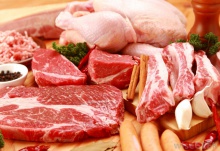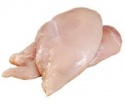Production
World meat production has grown by an average of 2.1% annually over the past 20 years, exceeding 310 million tons in 2015. Poultry produce grew at the highest rates - by 3.6% per year. If in 1995, the share of it was at the level of 27%, then in 2015 it reached 36%. Slower production of beef (together with buffalo meat) grew by an average of 1% per year during 1995-2015. However, the share of beef, like pork, declined and amounted to 22% and 38% in 2015, respectively. It is interesting that all this time in the world pork was more largely produced, but now the poultry almost caught up with it and, apparently, will be number 1 in the coming years.
The largest producers of beef in the world are the USA (15% of the world production), Brazil (14%), the EU (12%) and China (10%). Other countries are far from this four, which provides about half of world production.
The leader in the production of pork in the world is China with a share of 47%. Next are the EU (20%) and the USA (9%).
The largest poultry producers are the USA (18%), China (16%), the EU (12%) and Brazil (12%). Together they provide almost 60% of the world's production.
Consumption
In terms of meat consumption, leaders are the same as in production. In general, these are rich countries or countries with a large population. To these countries, Vietnam should be added as the fourth largest country in terms of pork demand after China, the EU, the US, and the Russian Federation, which is in the top five largest consumers of pork and poultry.
Top importers
Among the major meat importers, it is quite natural that are the countries that are its largest consumers.
The key importer of beef worldwide is the United States (20% of world imports), despite the fact that the country is also the largest producer of this meat. The large paying population of the cowboy country is distinguished by its traditional adherence to beef steaks and hamburgers, as a result of which imports continue to grow. By the way, the USA is also the world's fourth exporter of beef.
The second largest importer of beef is traditionally the Russian Federation (7.7%), but it has significantly reduced purchases over the past few years. On the one hand, solvency decreases, on the other hand, Western sanctions and the Russian import embargo are in effect.
Vietnam almost caught up with Russia in the import of this expensive meat (7.6%), although it has one and a half times less population. At the same time, imports continue to grow rapidly. Domestic production of beef in Vietnam is poorly developed, most of the beef the country imports.
Among the pork importers, Japan (16%) and China (13%) are the largest. Stable Japan does not very often get into the market news, unlike China, where every change in the regulation of imports or the support of local livestock production has a significant impact on pork prices around the world. So, it was the decrease in imports to China that became one of the reasons for the record high world prices for pork in 2014.
The geography of the top importers of poultry meat amazes with its variety. The four world leaders are Saudi Arabia, Mexico, the EU, and Vietnam. All import 800-900 thousand tons per year, which makes 7% -8% of the total world trade volume. At the same time, all these countries, except the EU, continue to increase purchases.
Interesting representatives of the top 10 importers of poultry meat are South Africa and the Philippines. These are relatively new players on the market, which are rapidly increasing imports.
Top exporters
The largest exporters of beef are Brazil (19% of world exports), Australia (18%) and India (16%). The last two countries have many cattle (along with buffalo) and are the world's top milk producers. Of course, they do not consume as much beef as the dairy industry leaves, so a large part is exported. In India, in addition, domestic consumption of beef is limited for religious and traditional reasons.
Brazil and the United States, on the contrary, are, so to speak, professional beef producers, actively using special meat breeds of animals.
Pork is provided by the USA (31% of world exports), EU (29%) and Canada (19%).
Together they ship about 80% of the world trade in this meat. Brazil is also a major player (7%), but in recent years has not demonstrated a positive dynamics in exports.
Among the exporters of poultry meat, there are also three leaders - Brazil (36% of world exports), USA (26%) and EU (12%). These countries have long been at the top, but it is worth noting two more new stars, which managed to significantly increase exports in recent years - this is Turkey (3.1%) and Ukraine (1.5%).
The situation in the market
After a significant reduction in price, the meat strengthened in the world market in 2016. The price increase, however, stopped by the end of the year, leaving prices at a much lower level for record prices in 2014.
The price situation in the meat market is cyclical, the nature of which is based on fluctuating production. The peak of prices for beef in 2014 was due to a decrease in the number of cattle in the US during previous years, while pork production declined under the influence of the spread of the epidemic diarrhea of swine in the US and African swine fever (ASF) in Europe.
Then, high meat prices together with feed prices rapidly declined, they began to stimulate an increase in production, launching a new round of the cycle. To this was added the decline in demand in some countries due to the deteriorating economic situation (lower oil prices and other reasons). Not the last factor was the Russian embargo on imports in response to the sanctions of Western countries.
The situation began in 2016 was characterized by another decrease in the supply of beef from Australia and the US and the launch of financial assistance for the storage of pork in the EU. Both factors contributed to the increase in prices. This was supplemented by a powerful factor in the revival of demand for pork from China along with a decrease in the supply of pigs for slaughter in the EU. The demand from Asian countries for pork and poultry continued to grow. Since the beginning of the fall, however, there has been some decline, caused by an increase in the supply of beef in the US, pork in Europe and a decrease in demand from China.
2017 began quietly in conditions of a balance between supply and demand and the absence of expectations for any significant changes. At the same time, an understanding of the nature of the cycles suggests the possibility of a gradual increase in the price of meat, which can be promoted by the predicted increase in the prices of feed.









